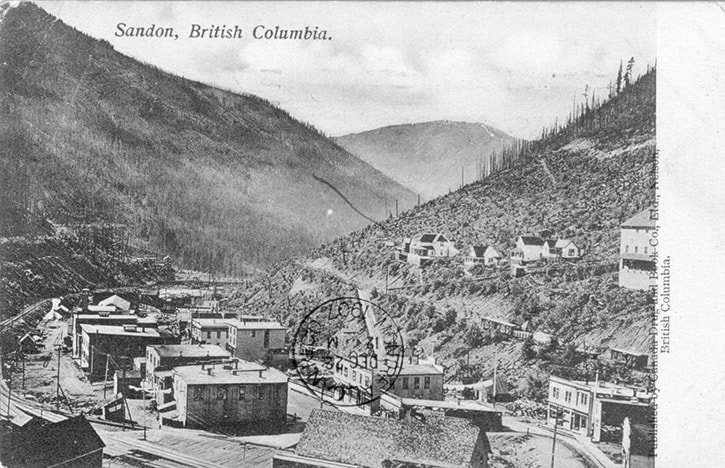GREG NESTEROFF
Special to Black Press
A series on West Kootenay/Boundary place names
Sandon, the West Kootenay’s greatest ghost town, was named after Sandon Creek, in turn named for prospector John Sandon.
Before we turn our attention to the town, we’ll examine Sandon the man — not that we know much about him. He was apparently born in Quebec around 1840, but doesn’t show up on any census return in Canada. (Perhaps his name was originally Jean Saindon?) In 1893, one source called him “an old-timer in the Northwest” and claimed “there are few places in which his freighting outfits have not penetrated,” but gave no further details.
The first actual sign of him is on the 1877 voters’ list, where he’s listed as a free miner at Perry Creek, a placer stream in the East Kootenay. In 1879, he’s listed as a laborer at Kootenay, and in 1881 and 1885 as a miner at Joseph’s Prairie.
On Aug. 21, 1889, Sandon pre-empted 320 acres eight miles north of Ainsworth, and started a ranch with Joseph Fletcher, for whom the creek that ran through the property was named. It went into the books as Lot 484.
In October 1890, Sandon was reported drowned on Kootenay Lake. A boat, oars, and hat found floating after a storm were identified as his.
However, Sandon turned up a few days later, vigorously denying his death. He said he wasn’t “fool enough to get into water that he couldn’t wade through to shore, should he be upset.”
Sandon was among the prospectors who flooded into the Slocan in the fall of 1891 upon reports of a major silver strike. He staked several claims, including the Slocan Star on Oct. 7. When recorded eight days later, its location was given as Sandon Creek, the first appearance of that name. Sandon and partner Bruce White also applied to buy land at the junction of Sandon and Carpenter creeks (the latter named for Eli Carpenter, one of the prospectors who started the rush). The Slocan Star proved fabulously wealthy, but not for Sandon, who sold his interests to White for $500 on Dec. 29, 1891.
But the Nelson Miner of April 23, 1892 predicted Sandon would yet find his fortune in farming: “The only rancher on the Lake who has made much of a showing is John Sandon, the veteran prospector … He has cleared several acres and taken out an irrigating ditch and says that he would have little difficulty in cultivating fully a fourth of the tract. He has planted seven acres in potatoes and put in all the garden seeds he could get hold of at Ainsworth and Nelson. If the Kaslo and Slocan mines prove good, Mr. Sandon has a gold mine, for he is within reach of all the camps in these districts — and the boys must have vegetables.”
In February 1893, Sandon left home with a man named Kenneth McLeod to go to McLeod’s ranch a few miles away — or maybe they were leaving McLeod’s ranch, or Kaslo, or Ainsworth. Accounts varied. Despite calm waters, their boat was found a few days later, bottom up on the lake. Their bodies were never recovered. The premature report of Sandon’s death in 1890 had been chillingly prescient.
“How the accident occurred is a mystery, but it is generally believed that liquor was the death-dealing agent,” the Spokane Review reported. “One of the unfortunate men was decidedly under the influence of whisky when they left Ainsworth, and took a bottle of it with him to use on the trip. The most reasonable theory is that one of them becoming tired of rowing the boat, they concluded to change places and in doing so the frail craft was upset and they were drowned.”

The paper added the Sandon left a family somewhere in California. Joseph Hetherington, who worked on Sandon’s farm for about a year, produced what was purportedly Sandon’s will. It was dated July 16, 1892 and bequeathed “all the real and personal estate to which I shall be entitled at the time of my demise unto Joseph Hetherington.” The will also appointed Hetherington executor.
However, the Kaslo Slocan Examiner of Sept. 30, 1893 smelled a rat, noting firstly that “no one knows that John Sandown [sic] really met his death from drowning or that he is really dead at all.”
Secondly, “The<>
